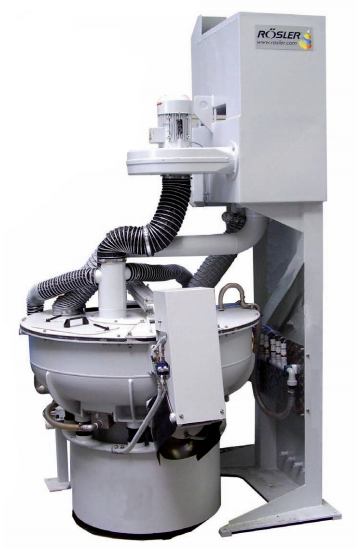
Part-on-Part Mass Finishing, Part 1 – Utilizing Work Pieces as the Media
, roslerusa - Back to overview
Mass finishing processes require pressure and constant rubbing to achieve the desired finishing results. In most cases, these applications require media specifically selected for its material, size, and shape to act upon work pieces and achieve the required effects. Some mass finishing applications also seek to eliminate or reduce part-on-part impingement or contact to protect delicate and high-value work pieces.
Conversely, part-on-part mass finishing intentionally exposes work pieces to impingement and encourages contact between work pieces and the resulting pressure to create finishing effects without the need for ceramic, plastic, and other types of media. The only additives required for such part-on-part finishing are water and the respective compounds.
Rosler Metal Finishing designs part-on-part mass finishing machines, known as WTA machines, which help reduce cost per piece through the elimination of media consumption and faster processing times.
Ideal Work Pieces
Part-on-part finishing is ideal for small, bulk parts
that are made of brass,
steel, aluminum, and even small ceramic components.
Contact pins
Pre-conditions for work pieces exposed to
part-on-part finishing include:
- Small sizes, approximately 0.1 to 2” in length or width.
- Simple, compact shapes.
- Sturdy nature without a need for delicate handling.
Zipper components
Part-on-part finishing is commonly used for:
- Small chain components including rollers and bushings.
- Small eyelets and hooks.
- Small stampings such as electrical contacts.
- Metal buttons.
- Rivets.
- Small metal tubing.
- Zipper parts including sliders and pull tabs.
- Rollers for small roller and needle bearings.
- Electrical contact pins.
- Small spindles and shafts.
- Ammunition cartridge components including blanks and cups for casings, deep drawn casings, bullets, and primers.
Rivets
Finishing Processes
With
the right compound(s) and suitable dosing system, part-on-part finishing
machines can handle nearly any type of surface finishing task.
Descriptions
of finishing tasks and the suggested compound include:
- Cleaning, degreasing, and de-oiling – In order to remove dirt, grease, or oil from the surface of the work piece, these tasks use pH neutral/slightly alkaline compounds.
- Pickling – This task utilizes a highly acidic compound to remove oxidation and light scale left over from annealing, brazing, or welding.
- Deburring and light edge breaking – Breaking and removing sharp edges, such as those left by machining, is achieved with a pH neutral compound.
- Surface grinding and smoothing – Grinding paste is added to help smooth surfaces.
- Polishing – To create very smooth surfaces, polishing paste is added.
- Brightening – pH neutral compounds are utilized to create bright, shiny surfaces.
- Passivation and corrosion protection – For protection from oxidation and short-term resistance to corrosion, pH neutral and slightly alkaline compounds are effective. Oil compounds are utilized for long-term protection against corrosion.
By using several compounds, multiple tasks such as
cleaning/degreasing, pickling, and drying or polishing, brightening,
passivation, and drying can be combined into a single, fully automatic process.
Rosler washing and drying system
Operation Benefits
In addition to the elimination of media costs and
ability to use successive compounds and achieve various processes in a single
machine, part-on-part mass finishing benefits include:
- Compact, space-saving designs since no additional space is required for a separate dryer.
- Simple material handling due to the elimination of work piece transfer between finishing machine and dryer.
- Fully automatic operation with suitable work piece loading and unloading equipment.
- No media issues such as lodging, chipping, or separation because no media is used.
- Batch operation with complete machine unload, eliminating the risk of parts getting mixed up.
- Different processing modes for different applications. Flow-through modes open drain valves allowing process liquid to flow straight through the machine. High water level modes close drain valves to retain process liquid in the machine.
- Use of multiple types of compound in one single process including acidic, pH neutral, and alkaline compounds as well as grinding and polishing paste.
Standard Machinery
Rosler
developed special WTA rotary vibrators
especially for part-on-part processing that not only allow running the finishing/washing
process, but also the subsequent drying stage in one single machine.
Rosler WTA Rotary Vibrator with drying system
Besides
WTA rotary vibrators, Rosler also offers centrifugal disk finishing machines
that allow part-on-part cleaning/washing and drying in a single machine.
Both
machine types allow the complete unloading of a batch of finished parts to take
place either by tilting the work bowl or by activating an unload gate in the
bottom of the work bowl.
Future posts in the part-on-part mass finishing
blog series will compare these machines and their applications.
The Rosler Way
The experts at Rosler are eager to learn more about your part-on-part mass finishing challenges in order to learn about your needs, develop a solution, and deliver results. We are confident that Rosler can design a process and machine to fit your needs and supply the most appropriate compound for your process. Contact us today to discuss your needs.
The complete Part-on-Part Series includes:
- Part 1 – Utilizing Work Pieces as the Media.
- Part 2 – Rotary Vibrators Versus Centrifugal Disk Machines.
- Part 3 – Effective Finishing for Ammunition Work Pieces.
Sign up for enews alerts to be notified of all Rosler blog posts!




